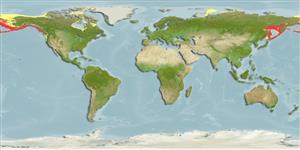Environment: milieu / climate zone / depth range / distribution range
Écologie
marin démersal; profondeur 2 - 710 m (Ref. 50610). Temperate; - 41°N
North Pacific: western Bering Sea south of Cape Navarin to Commander Islands, and Pacific Ocean to Sea of Okhotsk off southwestern Kamchatka and northern Kuril Islands; eastern Bering Sea and Aleutian Islands from Attu Island to northern California at Point Reyes.
Taille / Poids / Âge
Maturity: Lm ? range ? - ? cm
Max length : 30.5 cm TL mâle / non sexé; (Ref. 43939)
Épines dorsales (Total): 8 - 10; Rayons mous dorsaux (Total): 7-9; Épines anales 0; Rayons mous anaux: 6 - 9; Vertèbres: 39 - 42. Dorsal fins well forward and moderately separated; pectorals expanded, bottom 4 rays emarginate; pelvic fins reduced, in males length about equal to snout, in females half as long (Ref. 6885). Light grayish brown on dorsal surface, light yellow to orange on ventral surface; orange spot under each eye; dark saddle-like markings across back and sides; bright yellow on cirri; dusky on fins, dark blotch on posterior tip of anal fin in older individuals (Ref. 6885).
Common on soft bottoms (Ref. 2850). Feeds on worms, crustaceans, and small fishes (Ref. 4925).
Life cycle and mating behavior
Maturité | Reproduction | Frai | Œufs | Fécondité | Larves
Mecklenburg, C.W., T.A. Mecklenburg and L.K. Thorsteinson, 2002. Fishes of Alaska. American Fisheries Society, Bethesda, Maryland. xxxvii +1037 p. (Ref. 43939)
Statut dans la liste rouge de l'IUCN (Ref. 130435)
Menace pour l'homme
Harmless
Utilisations par l'homme
Plus d'informations
Noms communsSynonymesMétabolismePrédateursÉcotoxicologieReproductionMaturitéFraiRassemblement de ponteFéconditéŒufsDéveloppement de l'œuf
RéférencesAquacultureProfil d'aquacultureSouchesGénétiqueElectrophoresesHéritabilitéPathologiesTraitementNutrientsMass conversion
Outils
Articles particuliers
Télécharger en XML
Sources Internet
Estimates based on models
Preferred temperature (Ref.
123201): 0.2 - 6.6, mean 3 °C (based on 475 cells).
Phylogenetic diversity index (Ref.
82804): PD
50 = 0.5312 [Uniqueness, from 0.5 = low to 2.0 = high].
Bayesian length-weight: a=0.00389 (0.00180 - 0.00842), b=3.12 (2.94 - 3.30), in cm total length, based on all LWR estimates for this body shape (Ref.
93245).
Niveau trophique (Ref.
69278): 3.4 ±0.1 se; based on diet studies.
Résilience (Ref.
120179): Milieu, temps minimum de doublement de population : 1,4 à 4,4 années (Preliminary K or Fecundity.).
Fishing Vulnerability (Ref.
59153): Low vulnerability (21 of 100).
